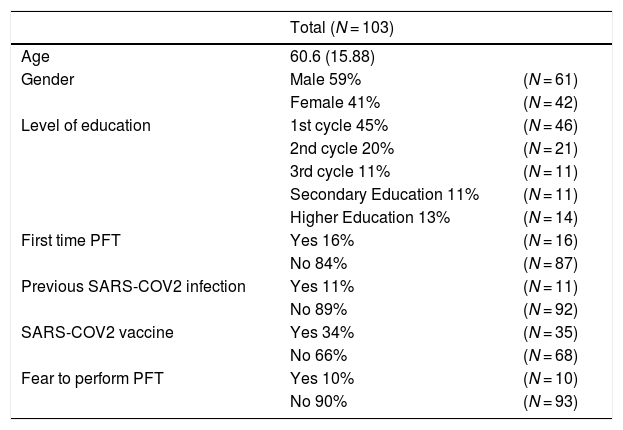The SARS-COV2 virus emerged in December 2019, in China.1 It quickly crossed borders and spread worldwide, affecting a large number of individuals. It was declared a pandemic on March 11, 2020.2 It is a highly contagious virus, transmitted person-to-person, not only by inhaling droplets and aerosols, but also by direct contact through surfaces.3
Pulmonary function tests (PFT), especially forced manoeuvres and possible cough induction, are aerosol generating procedures4,5 that can spread viral particles, thus presenting a high risk of contamination and cross-infection between patients and healthcare workers.6
Several scientific societies developed rules and recommendations on the reorganization and conditions of respiratory function laboratories with regard to the use of personal protective equipment by the technicians who carry out the PFTs, the ventilation of the rooms, the use of disposable materials, the cleaning of equipment and surfaces, the distance between tests, the absence of companions, the use of surgical masks only removed for the exam and the use of antimicrobial filters.7-12These procedures aim to minimize the risk of infection by direct and indirect contamination of patients, workers, and environment, maximizing everyone´s safety.
Despite these measures, we believe that patients’ perception and experience could differ from those of the healthcare workers. Thus, the aim of our study was to identify the fears and constraints experienced by patients, during the PFTs.
This study was carried out in April 2021 at the Respiratory Function Laboratory of the Centro Hospitalar de Vila Nova de Gaia/Espinho. It was a cross-sectional study, and the patients were selected consecutively after undergoing the procedure (PFT). All the invited individuals agreed to participate in the study.
The collected data was analysed using the SPSS Statistics program, using the Student T, Chi-squared, and Fisher's exact tests, with a p-value of <0.05 considered statistically significant.
The sample of this study is composed by 103 patients whose general characteristics are shown in Table 1.
Patients’ characteristics.
Age: mean (standard deviation); Other variables presented in relative and absolute frequency. PFT: Pulmonary function tests.
It was a heterogeneous sample, mainly composed of males (59%) and people whose level of education was only the first cycle of basic education (45%). Also, the majority had previously undergone a PFT (84%), had not been infected by SARS-COV2 (89%), and had not yet been vaccinated (66%).
Regarding the main objective of the study, we observed that 90% (N = 93) of the patients denied fear of undergoing a PFT at admission, and after the procedure the level of fear of a significant part of them (64%) remained the same, while 33% reported a decrease in their fear, having expressed a feeling of confidence and security with the measures implemented in the laboratory. Only one patient considered missing the exams, despite the fact that we are still in a period of pandemic.
As for the group of individuals who said they were afraid of undergoing a PFT (N = 10) at admission, the mean age was 53.8 years, and there was no gender predominance. Among these individuals, the majority had only completed the first cycle of education (50%) and 50% had a diagnosis of asthma. There was one case of previous infection by SARS-COV2, and 30% had already been vaccinated. The most frequently mentioned fear factors were the need to remove the mask, to put their mouth in the equipment, being in a closed space, and the presence of other patients in the waiting room. After undergoing a PFT, the level of fear for half of these patients remained the same, but the rest reported a decrease.
The comparative analysis between the two groups of patients – those who admitted and those who denied fear of undergoing a PFT at admission – did not show significant differences in relation to the variables assessed and no association was observed between any of the characteristics studied and the fear of undergoing a PFT, as noted in Table 2.
Comparison between patients with and without fear of undergoing pulmonary function tests.
Age: mean (standard deviation); other variables presented in relative and absolute frequency. Ed: education; PFT: Pulmonary function tests.
On the other hand, there were 3 patients who were not afraid of undergoing a PFT at admission who showed an increase in fear after undergoing the tests. These individuals had similar characteristics, such as young age (mean age of 32 years), a diagnosis of asthma, secondary education, and, in two cases, it was their first PFT. Despite all the procedures, they revealed discomfort during the experience, especially due to the need to remove the mask, put their mouths in the equipment, being in a closed space, mentioning as well that the waiting room was too small and did not allow for the recommended social distancing.
Despite strategies used to identify individuals suspected of being infected with SARS-COV2, there might be people with subclinical disease who can transmit it.11 Previous studies have shown there are differences between men and women regarding the risk of contracting SARS-COV2 infection, severe complications after infection, death, and psychological and emotional impact related to biological, social, economic, work, behavioural, and lifestyle factors.13 In our study, the analysed variables did not show a correlation with the fear felt by patients before and after undergoing the tests. Thus, we conclude that undergoing a PFT, in this period, constituted an individual and unique experience for each patient that results from their pathological background, but will be influenced by their beliefs, values, along with their social, economic, and cultural environment, reflecting each person's subjectivity in the way they face this pandemic.
A limitation of the study was the fact that 9.3% of patients missed the PFTs during the analysed period, and although we do not know the reasons for this – which might be related to the fear of contamination by SARS-COV2 – we found that these absences were consistent with those during the pre-pandemic period.









